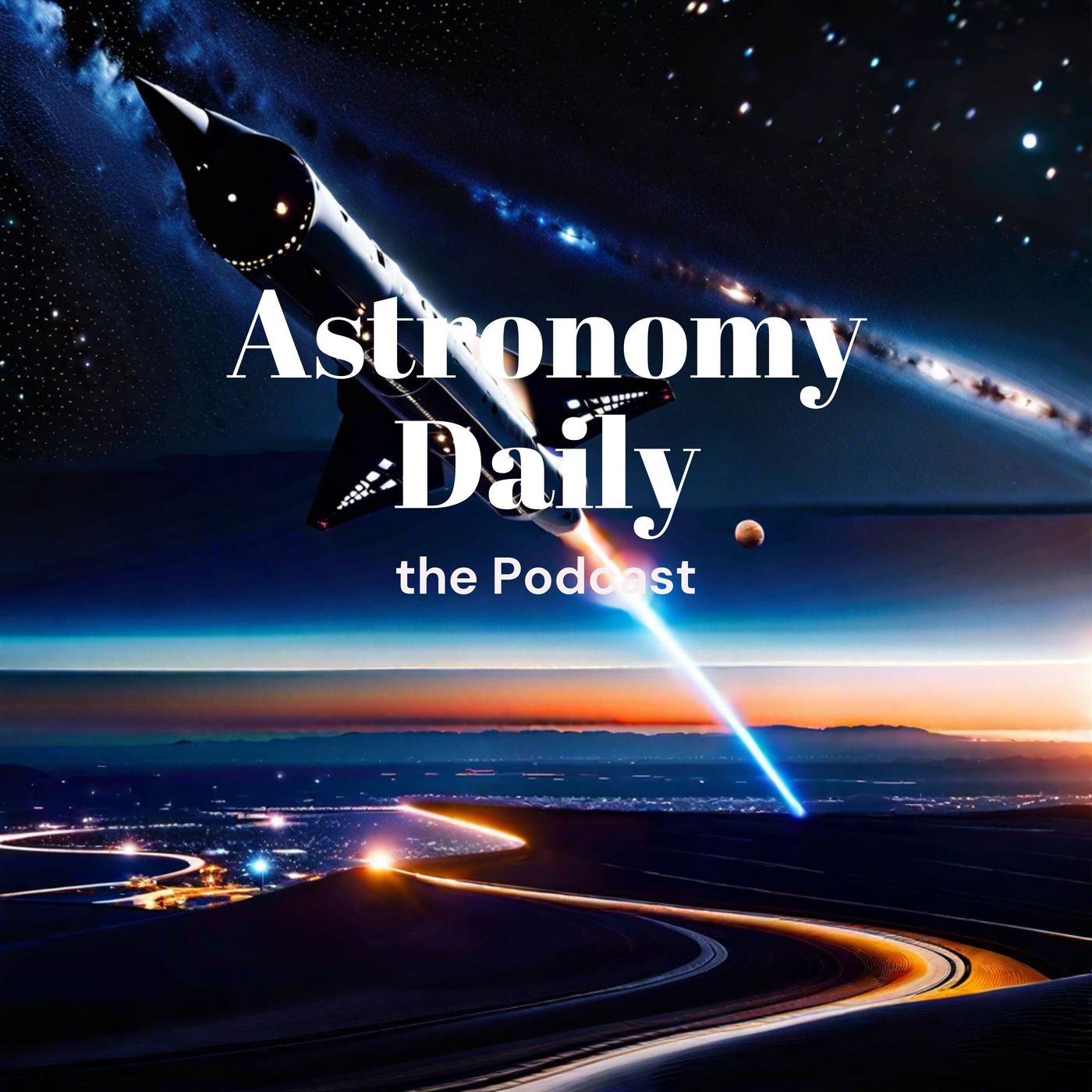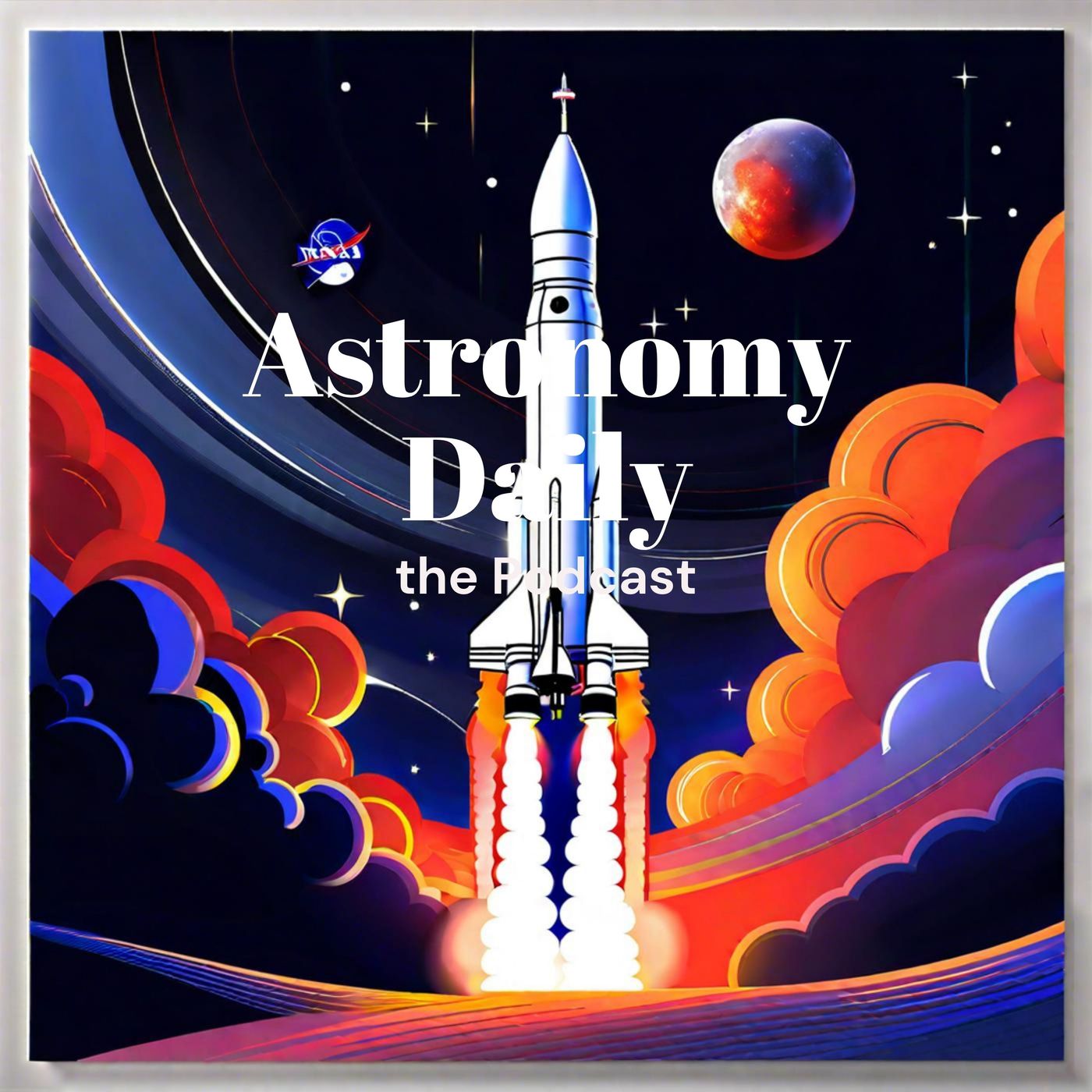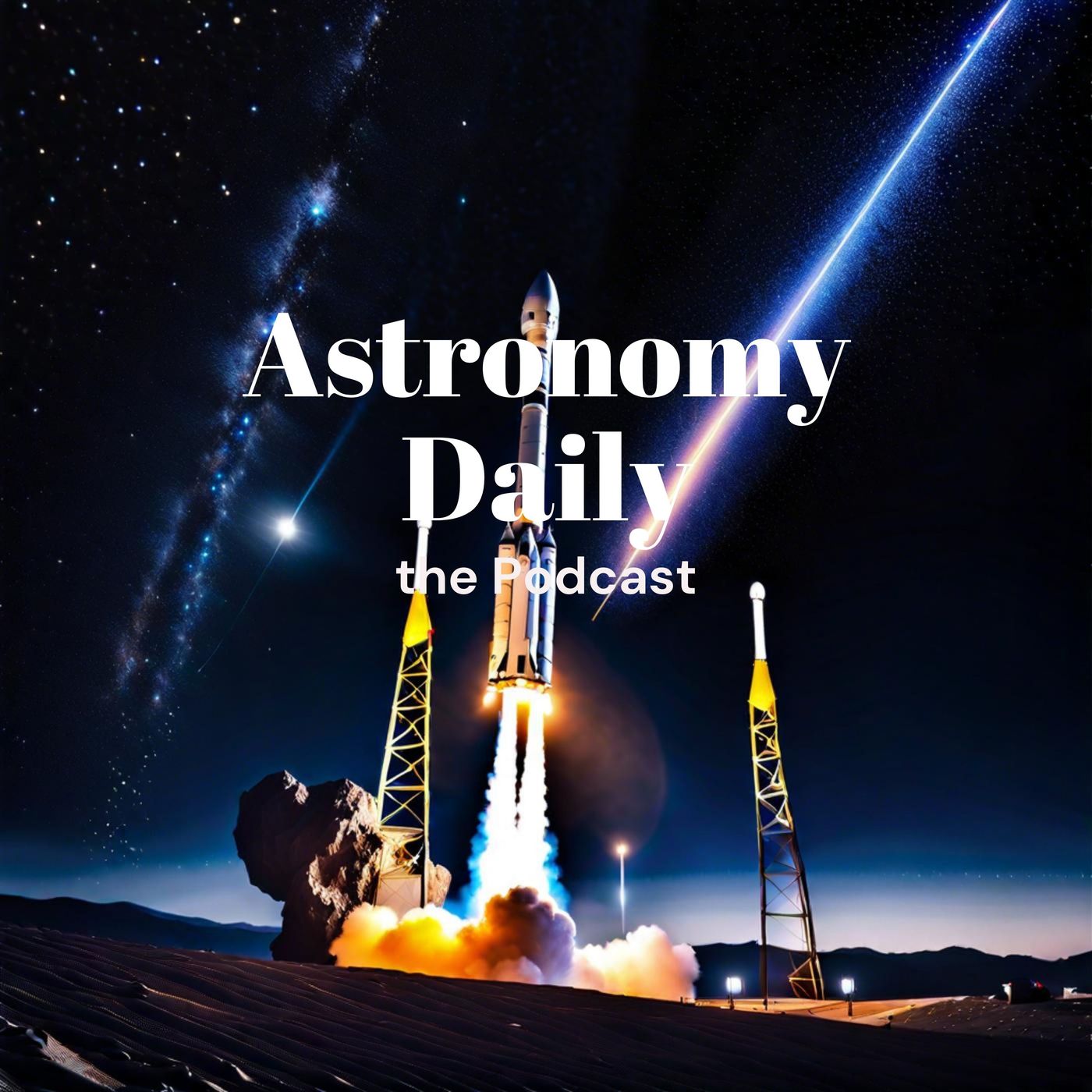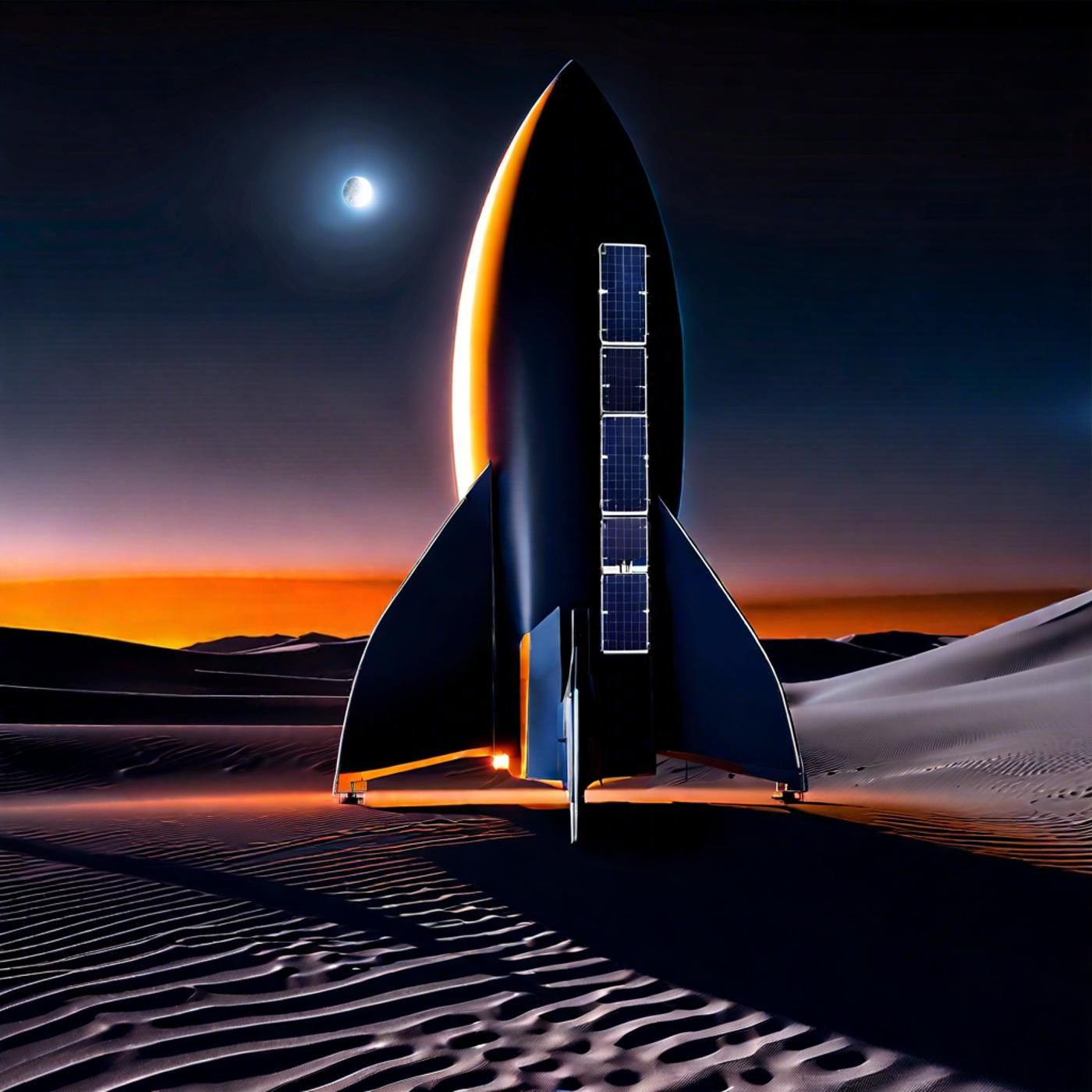S03E97: Europe's Ariane 6 Triumph & NASA's Iconic Logo Turns 65
Welcome to Astronomy Daily, your go-to podcast for the latest in space news. I'm your host, Anna, and I'm thrilled to have you with us today. We've got a jam-packed episode featuring some truly fascinating stories from the cosmos.
First up, we'll be...
Welcome to Astronomy Daily, your go-to podcast for the latest in space news. I'm your host, Anna, and I'm thrilled to have you with us today. We've got a jam-packed episode featuring some truly fascinating stories from the cosmos.
First up, we'll be talking about Europe's triumphant return to space launches with the debut of their next-generation Ariane 6 rocket, a significant milestone aiming to reestablish European access to space. Next, we'll wish a happy 65th birthday to NASA's beloved meatball logo, an iconic symbol that has inspired generations of explorers and dreamers. We'll also delve into a groundbreaking UC Riverside study that offers new insights into early life on Earth, potentially unlocking secrets about climate change and the search for extraterrestrial life. And lastly, we'll explore how recent discoveries about auroras and Earth's magnetic field could help us better protect our electrical infrastructure from space weather events. So buckle up and get ready for an amazing journey through the latest space discoveries and developments. Let's get started!
Episode Highlights
- Europe's Ariane 6 Rocket Launch: Europe has successfully launched its next-generation Ariane 6 rocket, ending a year-long gap in launches and marking a significant milestone in European space exploration.
- - NASA's Meatball Logo Turns 65: Celebrating the iconic red, white, and blue design that has become a symbol of exploration and discovery, with a special event at NASA Glenn.
- - UC Riverside's Study on Early Life: A groundbreaking study offers new insights into the early life on Earth, potentially unlocking secrets about climate change and the search for extraterrestrial life.
- - Auroras and Earth's Magnetic Field: Recent discoveries about auroras and Earth's magnetic field could help us better protect our electrical infrastructure from space weather events.
- Don't forget to visit our website for more episodes and the latest space news from our continually updating news feed. For even more space content and updates, follow us on Facebook, X, and TikTok. Until next time, keep looking up.
- Become a supporter of this podcast: Support Astronomy Daily.
- Check our unmissable sponsor deal from Malwarebytes - for a limited time get all the protection you need for 50% off! But this is a limited time offer. For details, visit www.bitesz.com/malwarebytes
Transcript
Welcome to Astronomy Daily, your go-to podcast for the latest in space news. I'm your host, Anna, and I'm thrilled to have you with us today. We've got a jam-packed episode featuring some truly fascinating stories from the cosmos. First up, we'll be talking about Europe's triumphant return to space launches with the debut of their next-generation Ariane 6 rocket, a significant milestone aiming to reestablish European access to space. Next, we’ll wish a happy 65th birthday to NASA's beloved 'meatball' logo, an iconic symbol that has inspired generations of explorers and dreamers. We'll also delve into a groundbreaking UC Riverside study that offers new insights into the early life on Earth, potentially unlocking secrets about climate change and the search for extraterrestrial life. And lastly, we’ll explore how recent discoveries about auroras and Earth's magnetic field could help us better protect our electrical infrastructure from space weather events. So buckle up and get ready for an amazing journey through the latest space discoveries and developments. Let's get started!
Kicking off our space news, Europe has successfully launched its next-generation Ariane 6 rocket, ending a year-long gap in launches and marking a significant milestone in European space exploration. The heavy-lift vehicle took off from its South American spaceport in French Guiana at 4 p.m. local time, or 19:00 GMT, on a mission designated VA262. This moment of triumph is more than a decade in the making and reinstates Europe's capability to launch satellites and other payloads into space. Josef Aschbacher, the director general of the European Space Agency, remarked, "A completely new rocket is not launched often, and success is far from guaranteed. I am privileged to have witnessed this historic moment when Europe’s new generation of the Ariane family lifted off – successfully – effectively reinstating European access to space." The successful demonstration of the Ariane 6 not only showcases the hard work and innovation of ESA and its partners but also underscores the resilience and adaptability of Europe's space industry.
The Ariane 6, developed at a cost estimated to be nearly $4 billion, provides a crucial upgrade to its predecessor, the Ariane 5, which had been operational since 1998. Over its illustrious career, Ariane 5 deployed more than 100 spacecraft into orbit, including NASA’s James Webb Space Telescope. However, the retirement of Ariane 5 in 2022 left Europe reliant on the smaller Vega rocket for launches, creating a gap in the medium to heavy-lift market. The scene has changed dramatically since the inception of the Ariane 5 over a quarter-century ago. Commercial space ventures like SpaceX have revolutionized the industry with reusable rockets, raising questions about the competitiveness of the non-reusable Ariane 6. Despite these pressures, ArianeGroup, a joint venture between Airbus and Safran, is banking on Ariane 6's success.
Today's launch saw the rocket's core stage, bolstered by two side-mounted solid rocket boosters, carry nine satellites and five onboard experiments to an altitude of about 600 kilometers. Despite an anomaly that caused a premature engine shutdown in its upper stage's auxiliary power unit, the mission successfully demonstrated key capabilities of the rocket, including its Vinci engine's orbital adjustment and deorbiting prowess. This mission is just the beginning; about 30 Ariane 6 launches are already booked, including 18 missions for Amazon's Project Kuiper satellites. Arianespace CEO Stéphane Israël assured that the end-of-mission anomaly would not affect future launches, and the next mission, planned for later this year, is set to deploy France's CSO-3 spy satellite. With a modular design adaptable for missions ranging from low Earth orbit deployments to deep space explorations, the Ariane 6 heralds a new chapter in European space capabilities. While the challenge of competing against reusable rockets remains, today's successful launch reinforces Europe's position in the global space race, promising more exciting missions to come.
Next, a big happy birthday to NASA's 'meatball' logo, which turns 65 this July 15th. Known for its iconic red, white, and blue design, the logo has become a symbol of exploration and discovery. If you've ever glanced at rocket launches, space missions, or even casual space themed merchandise, you’ve likely encountered this emblem that captures the essence of NASA’s mission. The 'meatball' logo was created in 1959 by James Modarelli at NASA's Lewis Research Center in Cleveland, which we now know as NASA Glenn. It’s a beautifully designed piece featuring elements that represent NASA’s aeronautics and space missions. The circular shape, white stars, and the red chevron or "wing" symbolize aeronautics, while the blue sphere stands for a planet. To celebrate this milestone, NASA Glenn is hosting a variety of activities aimed at inspiring the next generation. A public event at the Great Lakes Science Center in Cleveland will take place on the logo's birthday, offering free admission from 10 a.m. to 5 p.m. ET. The centerpiece of the celebration will be a cake-cutting ceremony scheduled for 10:30 a.m., featuring remarks from center leadership, a visit from the Modarelli family, and presentations from local and state dignitaries.
Visitors will not only celebrate the logo but also get a chance to engage in a host of science and art activities. Imagine meeting NASA Glenn’s award-winning photographers and videographers, participating in a coloring contest, and learning about the fascinating history behind the logo and its design. The event is set to be both educational and fun, emphasizing how creativity and science often go hand-in-hand at NASA. “NASA’s brand elements are wildly popular,” says Aimee Crane, the agency’s merchandising and branding clearance manager. Every year, NASA receives over 10,000 requests to merchandise items inspired by its brand. It’s not just rocket scientists who make NASA’s missions possible; artists, designers, and communicators play a crucial role as well. Kristen Parker, NASA Glenn’s communications director, hopes this inspires students to consider diverse careers within the agency.
But the celebration isn't limited to those in Northeast Ohio. You can join the festivities online by engaging with NASA Glenn on social media—share your favorite sightings of the 'meatball' logo or any anecdotes you have about its role in your life. Beyond its visual appeal, the logo is a testament to NASA Glenn’s extensive contributions to nearly every mission since NASA’s inception. This includes pioneering innovative technologies that revolutionize air travel, advance space exploration, and improve life on Earth. In conclusion, NASA's 'meatball' logo is not just an emblem; it's an enduring symbol of the human spirit's quest for knowledge and adventure. Here’s to another 65 years of exploration and discovery, under a logo that continues to inspire.
In other news, a groundbreaking study from UC Riverside has taken a monumental step in our understanding of early life on Earth. The research intricately weaves together decades of data, pulling from ancient rock records, genomic studies of modern organisms, and recent discoveries about the chemistry of early oceans, atmospheres, and continents. Despite years of research, scholars have long grappled with the puzzle of life's beginnings and early evolution. This new study brings us closer to solving that mystery by showing how Earth's earliest life forms—such as O2-producing bacteria and methane-producing archaea—shaped, and were in turn shaped by, their changing environments. One core message of the research is the importance of an interconnected view. You can't look at any single part of the record in isolation. By combining expertise across multiple fields—biology, geology, geochemistry, and genomics—scientists have painted a comprehensive picture of the journey of Earth's early microbes from their first appearances to their rise to ecological prominence. These microbial life forms started small, eking out an existence in isolated niches, but eventually went on to shape the world by producing oxygen through photosynthesis and influencing the nutrient cycles of nitrogen, iron, manganese, sulfur, and methane.
These microbes didn’t just live in their environments; they changed them, sometimes dramatically. As their numbers grew, they began to affect the oceans, continents, and atmosphere, causing Earth’s surface to evolve alongside them. For instance, continents emerged and the Earth became richer in oxygen, all influenced by these early microbial activities. The study also scrutinized rocks billions of years old that often lack visible fossils. By incorporating the chemistry of these rocks and the genomes of their living relatives, the research helps fill in the gaps of our understanding of early life. In essence, this research describes Earth's first significant interactions with microbes capable of altering the global environment. This paper holds profound implications not just for understanding our past but also our future. The insights could help predict how life and environments respond to climate change, both in the short term and the distant future. Additionally, understanding the evolution of early life on Earth could be crucial in our search for extraterrestrial life. The processes and products of microorganisms, such as methane and O2, could be the key indicators of life on other planets.
The research team at UC Riverside aims to support NASA's mission, specifically in understanding whether exoplanets can sustain life. By piecing together how Earth's early microbes influenced their environments, scientists hope to identify the signs we should look for in our quest to find life beyond Earth. This study isn't just an academic exercise; it brings us closer to answering some of the most fundamental questions about our existence. Where did we come from? How did life start? And perhaps more importantly, how can this knowledge inform our future both on this planet and as we explore others? These comprehensive findings offer a new perspective on life's early history and underscore the intricate dance between biology and environment, potentially guiding future studies and missions both on Earth and in space.
Lastly, let's talk about the fascinating phenomena known as auroras and their connection to Earth's magnetic field. Auroras have mesmerized humanity for millennia, displaying bright, colorful lights in the sky. But did you know that they're much more than just a beautiful spectacle? Scientists have recently made significant strides in understanding how auroras and Earth's magnetic field interact, with important implications for our infrastructure. Research led by Dr. Denny Oliveira of NASA's Goddard Space Flight Center sheds new light on the subject. The study shows that the angle at which interplanetary shocks—caused by solar particles and magnetic activity—hit Earth plays a critical role in generating geomagnetically induced currents (GICs). These currents can, in turn, pose a danger to our electrical infrastructure, such as power grids and pipelines. Auroras are created when particles ejected from the sun reach Earth's magnetic field, causing a geomagnetic storm. These storms compress Earth's magnetic field and create GICs. When these shocks occur, auroras serve as a visual warning. They essentially indicate that electric currents in space are interacting with our planet, which can lead to disruptions down here on Earth.
Dr. Oliveira and his team discovered that the impact angle of these shocks matters greatly. Shocks hitting Earth head-on are more likely to cause stronger geomagnetically induced currents because they more effectively compress the magnetic field. In contrast, shocks that strike at an angle generate weaker currents. This discovery offers an exciting opportunity to forecast these events more accurately and take protective measures. The researchers used data from a natural gas pipeline in Mäntsälä, Finland, to study these effects. This location is generally within the auroral region during active times, making it an excellent place to gauge the impact. By cross-referencing interplanetary shock data with recordings of geomagnetically induced currents, they could analyze how different shock angles and times of day affected the strength and frequency of these currents.
Their findings showed that more direct, frontal shocks result in higher peaks in geomagnetically induced currents, both immediately after the shock and during subsequent substorms. Interestingly, these peaks were most intense around midnight when the north pole was oriented between the sun and Mäntsälä. Localized substorms at midnight also caused dramatic auroral brightening. Given that the angles of these interplanetary shocks can be predicted up to two hours before impact, there’s a valuable window for setting up protections for our infrastructure. Power grid operators, for instance, could manage specific electric circuits when a shock alert is issued, mitigating the potential damage caused by GICs. Although this study is groundbreaking, it’s worth noting that the data were collected from a single location. Additional recordings from different latitudes could provide a more comprehensive picture. Wider access to such data would enable scientists to refine their forecasts and protective strategies even further.
In summary, understanding the impact angle of interplanetary shocks offers a promising pathway to better predict and mitigate the effects of geomagnetically induced currents. This not only helps in safeguarding our electrical networks but also enriches our knowledge of how these stunning auroras are intricately linked to the forces at play in space.
That's all for today's episode of Astronomy Daily. Thanks for tuning in! Don't forget to visit our website at astronomydaily dot i-o for more episodes and the latest space news from our continually updating newsfeed. For even more space content and updates, follow us on social media. You'll find us on Facebook, X, and TikTok. Until next time, keep looking up!
New to Astronomy Daily - The Podcast?
Here are some great episodes to start with.


















